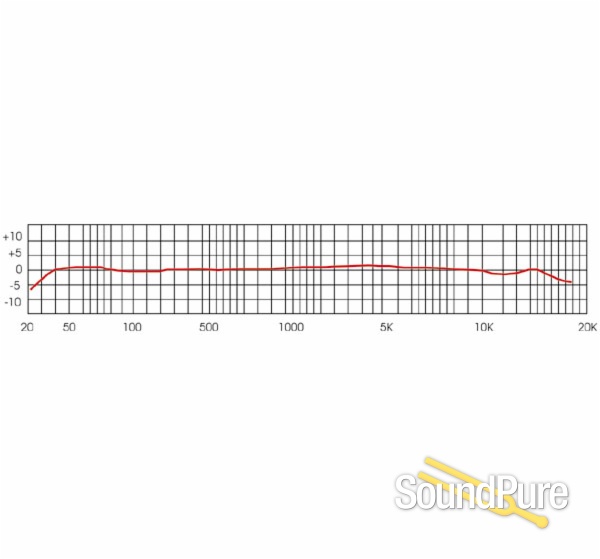Recording Electric Guitar - Session 4 Microphone Placement with Ross Hogarth
Grammy Award winning Producer/Engineer Ross Hogarth explains his critical microphone positioning technique using a Royer R-121 and Shure SM57 on a guitar cab.
- Signal Chain

The SF-24V is stereo coincident pair of ribbon mic capsules in a single, vacuum tube powered microphone. It has far more level than non-powered ribbons, allowing the use of a wider variety of mic preamps without concern for gain.
$4,999.00
The SF-24V vacuum tube stereo ribbon microphone is the pinnacle of Royer's SF-series stereo microphones. The sound pickup is lush, smooth and natural, with outstanding stereo imaging and superb transient response. The tube electronics provide increased midrange reach, unmatched clarity and detail, and an airiness previously unheard of in ribbon mics. Utilizing the same proprietary tube electronics as in the TEC Award winning R-122V ribbon microphones, the SF-24V delivers the ultimate in stereo ribbon miking for the true connoisseur of recorded sound.
The SF-24V’s independent tube circuits provide an output level of -38 dB, suitable for use with any professional preamplifier. With self-noise of lower than 18 dB, the SF-24V’s ultra-quiet operation is suitable for the most demanding classical and acoustic recording applications.
Like an SF-12, the SF-24V is actually two matched ribbon microphones, placed one above the other in a coincident pair, each aimed 45 degrees from center in the classic Blumlein configuration. The magnet/pole piece structure of each ribbon transducer delivers a wide, uniform frequency response with no substantial peaks or dips, and the 1.8-micron ribbons produce superb transient response. Frequency response is excellent regardless of the angle of sound striking the ribbons and off-axis coloration is negligible.
The SF-24V’s twin head amplifiers consist of low-noise, triode-connected military grade 5840 vacuum tubes. Designed for a wide range of applications, the SF-24V delivers -38 dB output and the drive capabilities only vacuum tube head amplifiers can provide. The circuits are devoid of typical vacuum tube coloration.
The SF-24V’s triode-configured cathode follower circuitry enables the microphone to drive long cable runs without sonic degradation or high-frequency loss. This capability is further enhanced by the SF-24V's dedicated power supply, which provides ample current to the vacuum tube electronics. Induced noise is virtually eliminated by the microphone's fully balanced outputs, which are electrically isolated with special purpose Jensen output transformers.
The SF-24V has far more level than non-powered ribbon microphones and its impedance matching circuitry places a perfect load on the ribbon element at all times. This allows the use of a wide variety of mic preamps without concern for gain and impedance matches, two critical issues with ribbon microphones. In addition, the microphone’s electronics shield the ribbon elements from any possibility of damage by phantom power, electrical glitches or miswired cables.
It is important to note that the SF-24V’s higher sensitivity creates no additional self-noise. All of the SF-24V’s increased level comes from its large, specially wound toroidal transformers, so there is no additional noise associated with the microphone's higher output. The tube system operates at less than unity, adding no noise of its own.
The SF-24V excels on full orchestra, choir and ensembles, classical piano, drum overheads, virtually all acoustic instruments, small vocal groups, a wide variety of percussion instruments, as a room mic, etc.
Like the SF-12, the SF-24V is uncanny for creating “you-are-there” stereo recordings that capture not only the instrument(s) being recorded, but, depending on how the microphone is positioned, varying degrees of the acoustical space. In addition, the increased sensitivity and impedance matching circuitry allows for more consistent results in a variety of recording situations and with a wider selection of mic pre’s.
For mono recording, phase compatibility between the two sides of the SF-24V is excellent, allowing you to combine the two channels perfectly in mono with no phase artifacts. This is particularly useful when capturing a wide sound field in mono; for instance, a singer who tends to move off the “sweet spot” of a mono microphone. Each side of the SF-24V can also be used as an independent mono microphone.
Features
Vacuum tube circuitry provides high output and impedance matching
True stereophonic (Blumlein and M-S) recording from one coincident microphone
High SPL capabilities
No distortion up to maximum SPL rating
Extremely low residual noise
Ribbon elements are not affected by heat or humidity
Absence of high frequency phase distortion
Equal sensitivity from front or back of elements
Consistent frequency response regardless of distance
High efficiency, matching toroidal transformers
Very low magnetic leakage
Applications
Orchestra
String Sections
Solo Strings
Brass and Woodwinds
Acoustic Piano
Harp
Choirs
Drum Overheads
Percussion Instruments
Acoustic Guitars
Large & Small Ensembles
Ambiance
Stereo to Mono

After years of designing and manufacturing microphones in Los Angeles, David Royer teamed up with Rick Perrotta, former President and co-founder of the prestigious Matchless Guitar Amplifier Company, and together with studio owner Rafael Villafane and musician/marketing director John Jennings, formed Royer Labs, a California based company dedicated to the development and production of high quality ribbon microphones and transducer elements. DAVID ROYER Best known for his ribbon mics, David has designed countless other mics and outboard devices that are in use throughout numerous LA studios. When David's not designing new gear, his idea of fun is climbing desert mountains or pounding dirt roads in his new pickup. RICK PERROTTA Rick Perrotta's name may sound familiar - he and Rafael Villafane owned LA's Baby-O Recorders during the 80's, then Rick went on to co-found Matchless Guitar Amplifiers, where he was President and Production Chief of the prestigious amp line until 1995. At the helm of Royer Labs, Rick brings an extraordinary level of craftsmanship to every Royer microphone (hold one in your hand and you may never give it back!). JOHN JENNINGS John worked for years as a guitar player and singer, in the studio and on the road. He took an 8-year detour into the corporate world as VP Sales & Marketing for an LA communications firm, but came to his senses in 1996 and ditched the suit to get into pro-audio manufacturing and sales. John handles sales and marketing for Royer Labs. RAFAEL VILLAFANE Rafael Villafane co-founded Baby'O Recorders with Rick. He has produced a #1 and numerous top ten hits in the US and abroad. He drinks too much. Owns a club in Acapulco (Baby'O). If you can prove you own a Royer product, the first ten tequilas are on him---really. Drives too fast. Been doing a record for ten years he STILL can't finish. Has a six-second attention span. He torched a school with young pal Jeff "Skunk" Baxter in Mexico City when they were kids. What else? Oh yeah, he's Mexican... nobody's perfect. CHRIS PERROTTA As another co-founder of Matchless Amplifier Company, Chris was responsible for the high quality detail work that Matchless is famous for, including the light up "dashboard" and three dimensional logo. At Royer, Chris is the chief mechanical designer and another confirmed precision freak. Every Royer microphone owes its beauty and elegance to Chris wonderful interpretations of the designers art.

Grammy Award winning Producer/Engineer Ross Hogarth explains his critical microphone positioning technique using a Royer R-121 and Shure SM57 on a guitar cab.
 Payments as low as $113/mo.
Payments as low as $113/mo.